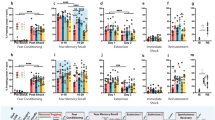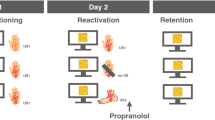Abstract
The capacity to adapt to new situations is one of the most important features of memory. When retrieved, memories may undergo a labile state that is sensitive to modification. This process, called reconsolidation, can lead to memory updating through the integration of new information into a previously consolidated memory background. Thus reconsolidation provides the opportunity to modify an undesired fear memory by updating its emotional valence to a less aversive level. Here we evaluated whether a fear memory can be reinterpreted by the concomitant presentation of an appetitive stimulus during its reactivation, hindering fear expression. We found that memory reactivation in the presence of appetitive stimuli resulted in the suppression of a fear response. In addition, fear expression was not amenable to reinstatement, spontaneous recovery, or rapid reacquisition. Such effect was prevented by either systemic injection of nimodipine or intra-hippocampal infusion of ifenprodil, indicating that memory updating was mediated by a reconsolidation mechanism relying on hippocampal neuronal plasticity. Taken together, this study shows that reconsolidation allows for a ‘re-signification’ of unwanted fear memories through the incorporation of appetitive information. It brings a new promising cognitive approach to treat fear-related disorders.
Similar content being viewed by others
Log in or create a free account to read this content
Gain free access to this article, as well as selected content from this journal and more on nature.com
or
References
Archbold GEB, Bouton ME, Nader K (2010). Evidence for the persistence of contextual fear memories following immediate extinction. Eur J Neurosci 31: 1303–1311.
Berridge KC, Kringelbach ML (2013). Neuroscience of affect: brain mechanisms of pleasure and displeasure. Curr Opin Neurobiol 23: 294–303.
Besnard A (2012). A model of hippocampal competition between new learning and memory updating. J Neurosci 32: 3281–3283.
Besnard A, Caboche J, Laroche S (2012). Reconsolidation of memory: a decade of debate. Prog Neurobiol 99: 61–80.
Blundell J, Kouser M, Powell CM (2008). Systemic inhibition of mammalian target of rapamycin inhibits fear memory reconsolidation. Neurobiol Learn Mem 90: 28–35.
Bouton ME (2002). Context, ambiguity, and unlearning: sources of relapse after behavioral extinction four mechanisms of relapse. Biol Pschiatry 52: 976–986.
Bouton ME, Westbrook RF, Corcoran Ka, Maren S (2006). Contextual and temporal modulation of extinction: behavioral and biological mechanisms. Biol Psychiatry 60: 352–360.
Bouton ME, Winterbauer NE, Todd TP (2012). Relapse processes after the extinction of instrumental learning: renewal, resurgence, and reacquisition. Behav Processes 90: 130–141.
Bustos SG, Maldonado H, Molina Va (2009). Disruptive effect of midazolam on fear memory reconsolidation: decisive influence of reactivation time span and memory age. Neuropsychopharmacology 34: 446–457.
Clem RL, Huganir RL (2010). Calcium-permeable AMPA receptor dynamics mediate fear memory erasure. Science 330: 1108–1112.
Cukor J, Spitalnick J, Difede J, Rizzo A, Rothbaum BO (2009). Emerging treatments for PTSD. Clin Psychol Rev 29: 715–726.
De Oliveira Alvares L, Crestani aP, Cassini LF, Haubrich J, Santana F, Quillfeldt Ja (2013). Reactivation enables memory updating, precision-keeping and strengthening: exploring the possible biological roles of reconsolidation. Neuroscience 244: 42–48.
De Oliveira Alvares L, Einarsson EÖ, Santana F, Crestani AP, Haubrich J, Cassini LF et al (2012). Periodically reactivated context memory retains its precision and dependence on the hippocampus. Hippocampus 22: 1092–1095.
Debiec J, LeDoux JE (2006). Noradrenergic signaling in the amygdala contributes to the reconsolidation of fear memory: treatment implications for PTSD. Ann NY Acad Sci 1071: 521–524.
Díaz-Mataix L, Debiec J, LeDoux JE, Doyère V (2011). Once the US-triggered reconsolidation of fear memory and its CS neural representation is disrupted, a rein- statement procedure does not lead to their recovery. J Neurosci 31: 9538–9543.
Doyère V, Debiec J, Monfils M-H, Schafe GE, LeDoux JE (2007). Synapse-specific reconsolidation of distinct fear memories in the lateral amygdala. Nat Neurosci 10: 414–416.
Flavell CR, Barber DJ, Lee JLC (2011). Behavioural memory reconsolidation of food and fear memories. Nat Commun 2: 504.
Forcato C, Rodríguez MLC, Pedreira ME, Maldonado H (2010). Reconsolidation in humans opens up declarative memory to the entrance of new information. Neurobiol Learn Mem 93: 77–84.
Frankland PW, Ding H-K, Takahashi E, Suzuki A, Kida S, Silva AJ (2006). Stability of recent and remote contextual fear memory. Learn Mem 13: 451–457.
Gamache K, Pitman RK, Nader K (2012). Preclinical evaluation of reconsolidation blockade by clonidine as a potential novel treatment for posttraumatic stress disorder. Neuropsychopharmacology 37: 2789–2796.
Gold PE (1986). Glucose modulation of memory storage processing. Behav Neural Biol 45: 342–349.
Gold PE, Korol DL (2012). Making memories matter. Front Integr Neurosci 6: 116.
Gräff J, Joseph NF, Horn ME, Samiei A, Meng J, Seo J et al (2014). Epigenetic priming of memory updating during reconsolidation to attenuate remote fear memories. Cell 156: 261–276.
Gross CT, Canteras NS (2012). The many paths to fear. Nat Rev Neurosci 13: 651–658.
Hupbach A, Gomez R, Hardt O, Nadel L (2007). Reconsolidation of episodic memories: a subtle reminder triggers integration of new information. Learn Mem 14: 47–53.
Lee JLC (2009). Reconsolidation: maintaining memory relevance. Trends Neurosci 32: 413–420.
Lee JLC, Milton AL, Everitt BJ (2006). Reconsolidation and extinction of conditioned fear: inhibition and potentiation. J Neurosci 26: 10051–10056.
Mamou C Ben, Gamache K, Nader K (2006). NMDA receptors are critical for unleashing consolidated auditory fear memories. Nat Neurosci 9: 1237–1239.
Messier C (2004). Glucose improvement of memory: a review. Eur J Pharmacol 490: 33–57.
Milekic MH, Alberini CM (2002). Temporally graded requirement for protein synthesis following memory reactivation. Neuron 36: 521–525.
Milton AL, Merlo E, Ratano P, Gregory BL, Dumbreck JK, Everitt BJ (2013). Double dissociation of the requirement for GluN2B- and GluN2A-containing NMDA receptors in the destabilization and restabilization of a reconsolidating memory. J Neurosci 33: 1109–1115.
Monfils M-H, Cowansage KK, Klann E, LeDoux JE (2009). Extinction-reconsolidation boundaries: key to persistent attenuation of fear memories. Science 324: 951–955.
Nader K, Schafe GE, Le Doux JE (2000). Fear memories require protein synthesis in the amygdala for reconsolidation after retrieval. Nature 406: 722–726.
Olshavsky ME, Jones CE, Lee HJ, Monfils M-H (2013a). Appetitive behavioral traits and stimulus intensity influence maintenance of conditioned fear. Front Behav Neurosci 7: 179.
Olshavsky ME, Song BJ, Powell DJ, Jones CE, Monfils M-H, Lee HJ (2013b). Updating appetitive memory during reconsolidation window: critical role of cue-directed behavior and amygdala central nucleus. Front Behav Neurosci 7: 186.
Parsons RG, Ressler KJ (2013). Implications of memory modulation for post-traumatic stress and fear disorders. Nat Neurosci 16: 146–153.
Rao-Ruiz P, Rotaru DC, Van Der Loo RJ, Mansvelder HD, Stiedl O, Smit AB et al (2011). Retrieval-specific endocytosis of GluA2-AMPARs underlies adaptive reconsolidation of contextual fear. Nat Neurosci 14: 1302–1308.
Rescorla Ra, Heth CD (1975). Reinstatement of fear to an extinguished conditioned stimulus. J Exp Psychol Anim Behav Process 1: 88–96.
Robinson MJF, Berridge KC (2013). Instant transformation of learned repulsion into motivational ‘wanting’. Curr Biol 23: 282–289.
Rodriguez-Ortiz CJ, la Cruz V De, Gutiérrez R, Bermudez-Rattoni F (2005). Protein synthesis underlies post-retrieval memory consolidation to a restricted degree only when updated information is obtained. Learn Mem 12: 533–537.
Rothbaum BO, Davis M (2003). Applying learning principles to the treatment of post-trauma reactions. Ann NY Acad Sci 1008: 112–121.
Schiller D, Monfils M-H, Raio CM, Johnson DC, Ledoux JE, Phelps Ea (2010). Preventing the return of fear in humans using reconsolidation update mechanisms. Nature 463: 49–53.
Sierra RO, Cassini LF, Santana F, Crestani AP, Duran JM, Haubrich J et al (2013). Reconsolidation may incorporate state-dependency into previously consolidated memories. Learn Mem 20: 379–387.
Steckler T, Risbrough V (2012). Pharmacological treatment of PTSD—established and new approaches. Neuropharmacology 62: 617–627.
Stern CAJ, Gazarini L, Takahashi RN, Guimarães FS, Bertoglio LJ (2012). On disruption of fear memory by reconsolidation blockade: evidence from cannabidiol treatment. Neuropsychopharmacology 37: 1–11.
Suzuki A, Josselyn Sa, Frankland PW, Masushige S, Silva AJ, Kida S (2004). Memory reconsolidation and extinction have distinct temporal and biochemical signatures. J Neurosci 24: 4787–4795.
Suzuki A, Mukawa T, Tsukagoshi A, Frankland PW, Kida S (2008). Activation of LVGCCs and CB1 receptors required for destabilization of reactivated contextual fear memories. Learn Mem 15: 426–433.
Winocur G, Frankland PW, Sekeres M, Fogel S, Moscovitch M (2009). Changes in context-specificity during memory reconsolidation: selective effects of hippocampal lesions. Learn Mem 16: 722–729.
Winters BD, Tucci MC, DaCosta-Furtado M (2009). Older and stronger object memories are selectively destabilized by reactivation in the presence of new information. Learn Mem 16: 545–553.
Acknowledgements
We acknowledge Mrs Zelma Regina V de Almeida for her kind technical assistance and Dr Carla Dalmaz and Dr Maria Elisa Calcagnotto (Depto Biochemisty, ICBS) for their relevant contributions to this paper.
Author information
Authors and Affiliations
Corresponding author
Additional information
Supplementary Information accompanies the paper on the Neuropsychopharmacology website
Rights and permissions
About this article
Cite this article
Haubrich, J., Crestani, A., Cassini, L. et al. Reconsolidation Allows Fear Memory to Be Updated to a Less Aversive Level through the Incorporation of Appetitive Information. Neuropsychopharmacol 40, 315–326 (2015). https://doi.org/10.1038/npp.2014.174
Received:
Revised:
Accepted:
Published:
Issue date:
DOI: https://doi.org/10.1038/npp.2014.174
This article is cited by
-
Social interaction-induced fear memory reduction: exploring the influence of dopamine and oxytocin receptors on memory updating
Translational Psychiatry (2024)
-
Muscarinic receptor activation overrides boundary conditions on memory updating in a calcium/calmodulin-dependent manner
Neuropsychopharmacology (2023)
-
Communication as the Origin of Consciousness
Integrative Psychological and Behavioral Science (2023)
-
Lack of drug-induced post-retrieval amnesia for auditory fear memories in rats
BMC Biology (2021)
-
GluN2B and GluN2A-containing NMDAR are differentially involved in extinction memory destabilization and restabilization during reconsolidation
Scientific Reports (2021)



